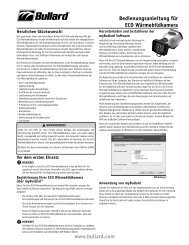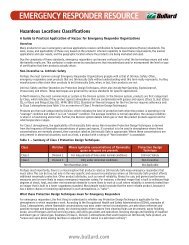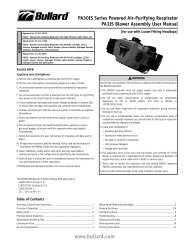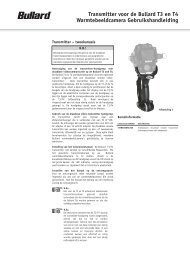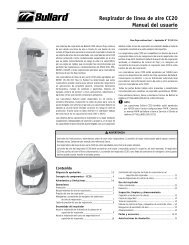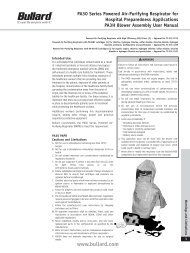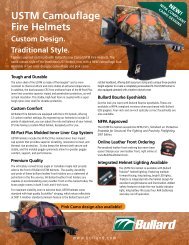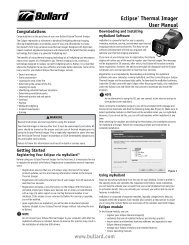RT Series Respirator Hood User Manual www.bullard.com
RT Series Respirator Hood User Manual www.bullard.com
RT Series Respirator Hood User Manual www.bullard.com
Create successful ePaper yourself
Turn your PDF publications into a flip-book with our unique Google optimized e-Paper software.
Inspection, Cleaning and Storage<br />
8<br />
Inspection, Cleaning and Storage<br />
WARNING<br />
Failure to heed these instructions could result in death or serious injury.<br />
LEAVE WORK AREA IMMEDIATELY IF:<br />
- Any respirator <strong>com</strong>ponent be<strong>com</strong>es damaged<br />
- Airflow into respirator hood stops or slows down<br />
- Air pressure gauge drops below the minimum specified in the<br />
Breathing Air Pressure Table<br />
- Pressure is felt in the ears<br />
- Breathing be<strong>com</strong>es difficult<br />
- You be<strong>com</strong>e dizzy, nauseous, too hot, too cold, or ill<br />
- You taste, smell, or see contaminants inside<br />
respirator hood<br />
- Your vision be<strong>com</strong>es impaired<br />
WARNING<br />
Do not store respirator in your work area or leave it unattended in<br />
a contaminated environment. Respirable contaminants can remain<br />
suspended in the air for several hours after work activity ceases,<br />
even though you may not see them. Proper work practice requires you<br />
to wear the respirator until you are outside the contaminated area.<br />
If you place or store the respirator in a contaminated environment,<br />
contaminants, dirt, and dust could get into the respirator. When you put<br />
the respirator back on, you could breathe in contaminants upon reuse.<br />
Failure to heed these instructions could result in death or serious injury.<br />
Bullard <strong>RT</strong> <strong>Series</strong> respirators have a limited service life. Therefore, a regular<br />
inspection and replacement program must be conducted.<br />
Bullard <strong>RT</strong> <strong>Series</strong> respirators and all <strong>com</strong>ponent parts and assemblies should<br />
be inspected for damage or excessive wear before and after each use to<br />
ensure proper functioning. Immediately remove the respirator from service<br />
and replace parts or assemblies that show any sign of failure or excessive<br />
wear that might reduce the degree of protection originally provided.<br />
Use only Bullard <strong>RT</strong> <strong>Series</strong> respirator <strong>com</strong>ponents and replacement parts<br />
manufactured by Bullard and approved by NIOSH for use with these<br />
respirators.<br />
Since respirator use and the quality of maintenance performed vary with<br />
each job site, it is impossible to provide a specific time frame for respirator<br />
replacement.<br />
Inspect all <strong>com</strong>ponents of this respirator system during cleaning and before<br />
and after each use for signs of wear, tear or damage that might reduce the<br />
degree of protection originally provided. <strong>Respirator</strong>s used by more than<br />
one person must be cleaned, inspected and sanitized after each use. If not<br />
cleaned, contamination may cause illness or disease.<br />
<strong>Hood</strong><br />
Inspection<br />
Inspect the hood material for rips, tears, or damage from excessive wear that<br />
might reduce the degree of protection originally provided. Inspect the inner<br />
neck cuff for elasticity. The respirator’s plastic lens should be inspected for<br />
cracks, scratches or any other signs of damage.<br />
Disassemble the breathing tube from the hood by removing the nylon hose<br />
clamp. To remove the hose clamp, slide the locks sideways in opposite<br />
directions.<br />
If damage is detected, replace immediately with Bullard replacement part(s)<br />
or remove the respirator from service.<br />
Cleaning<br />
Bullard does not re<strong>com</strong>mend laundering the hood. When the hood be<strong>com</strong>es<br />
dirty, it should be discarded and replaced. The respirator’s plastic lens should<br />
be hand-sponged with warm water and mild detergent, rinsed, and air-dried.<br />
After cleaning and before reassembling, once again carefully inspect parts for<br />
signs of damage.<br />
<strong>www</strong>.<strong>bullard</strong>.<strong>com</strong><br />
WARNING<br />
The air you breathe will not be clean unless the respirator you wear<br />
is clean. Failure to heed this warning could result in death or serious<br />
injury.<br />
WARNING<br />
Do not use volatile solvents for cleaning this respirator or any parts and<br />
assemblies. Strong cleaning and disinfecting agents, and many solvents,<br />
can damage the plastic parts and reduce the protective properties of<br />
the respirator. Failure to heed these instructions may result in minor or<br />
moderate injury and/or equipment damage.



